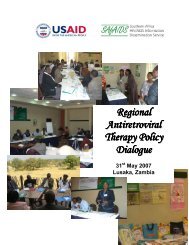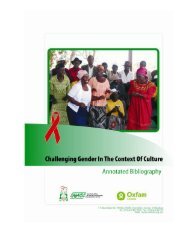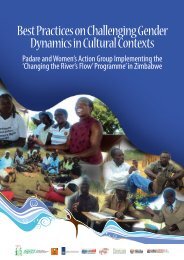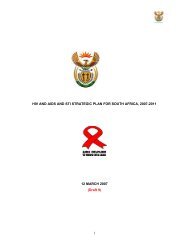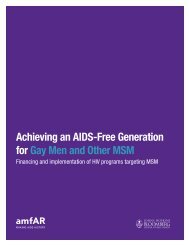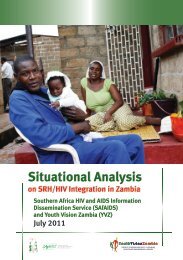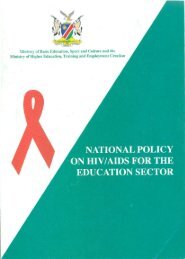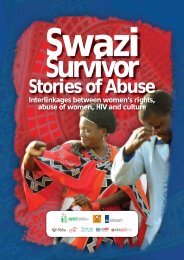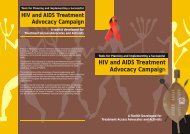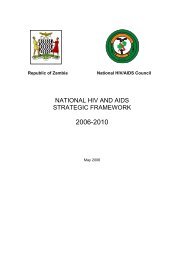Implementation of regional and international HIV prevention - SAfAIDS
Implementation of regional and international HIV prevention - SAfAIDS
Implementation of regional and international HIV prevention - SAfAIDS
- No tags were found...
You also want an ePaper? Increase the reach of your titles
YUMPU automatically turns print PDFs into web optimized ePapers that Google loves.
6.2.2 Dissemination <strong>and</strong> use <strong>of</strong> <strong>HIV</strong>/AIDS monitoring <strong>and</strong> evaluationinformationIn both countries the <strong>HIV</strong> <strong>and</strong> AIDS co-ordinating bodies, i.e., NERCHA for Swazil<strong>and</strong> <strong>and</strong> NACfor Zambia, are m<strong>and</strong>ated to publish <strong>and</strong> disseminate information on all output indicatorsreflected within their <strong>HIV</strong> <strong>and</strong> AIDS Strategic Plans. These co-ordinating bodies also publishannual reports on all indicators in the strategic plans. The M&E units within the co-ordinatingbodies lead the mid-term <strong>and</strong> end-<strong>of</strong>-term review <strong>of</strong> the <strong>HIV</strong> <strong>and</strong> AIDS strategic plans.Such reviews consist not only <strong>of</strong> the analysis <strong>of</strong> indicator scores, but also other consultativeprocesses, using qualitative research techniques to determine the challenges, implementationimpediments <strong>and</strong> achievements. The two countries are signatory to the UNGASS <strong>and</strong> thusproduce <strong>and</strong> present the bi-annual UNGASS report.Swazil<strong>and</strong> NSP states that tracking the national response to <strong>HIV</strong> <strong>and</strong> AIDS should be donethrough ongoing tracking <strong>of</strong> core indicators <strong>and</strong>, mid-term <strong>and</strong> end-<strong>of</strong>-term reviews <strong>of</strong> theNational Strategic Plan for <strong>HIV</strong> <strong>and</strong> AIDS. Core indicators for every sub-thematic area shouldbe tracked on a regular basis. Indicator scores are then calculated on a quarterly basis for alloutput-level indicators, <strong>and</strong> on an annual or biennial basis for all outcome-level <strong>and</strong> impactlevelindicators. The national M&E core data sources are defined. These core data sourcesconsist <strong>of</strong> both independent serological <strong>and</strong> behavioural surveillance, as well as the m<strong>and</strong>atorycollection <strong>of</strong> <strong>HIV</strong> service coverage data from all implementers <strong>of</strong> <strong>HIV</strong> <strong>and</strong> AIDS interventions.Such m<strong>and</strong>atory data collection on the nature <strong>and</strong> extent <strong>of</strong> <strong>HIV</strong> <strong>and</strong> AIDS service coverageis done using the Swazil<strong>and</strong> <strong>HIV</strong> <strong>and</strong> AIDS Programme Monitoring System (SHAPMoS). Thissystem is well-developed in terms <strong>of</strong> literature <strong>and</strong> support materials, but most NGO partnershave not been adhering to its requirement. NERCHA also has the m<strong>and</strong>ate <strong>and</strong> financialsupport to develop quarterly reports for all output indicators in the NSP, <strong>and</strong> an annual reportfor all indicators in the NSP. The M&E Unit at NERCHA is responsible for facilitating dissemination<strong>of</strong> information. Different <strong>and</strong> appropriate dissemination channels, including publication on itswebsite, are used to achieve this objective. However, the utilisation <strong>of</strong> data collected during M& E in informing policy has been a challenge.40In Zambia NAC has developed a National <strong>HIV</strong> <strong>and</strong> AIDS M&E System to allow the country totrack its progress towards the goals <strong>and</strong> objectives as stated in the NASF. In order to establisha national M&E system, NAC operationalised the NAC activity reporting systems using NACNARFs as a means <strong>of</strong> capturing <strong>HIV</strong> <strong>and</strong> AIDS programme monitoring data from provincial<strong>and</strong> district levels. Data sources for M&E <strong>of</strong> the national <strong>HIV</strong> <strong>and</strong> AIDS response in Zambiaconsist <strong>of</strong> the following: the NARF, Cohort Studies; Education Management Information System(EMIS); Special Education Surveys that feed into the EMIS; HMIS; National Composite PoliceIndex (NDPCI) <strong>and</strong> Sentinel Surveys. Others include: UNAIDS Financial Resource Flows Survey;Workplace Survey; Zambia Demographic Health Survey (ZDHS) which is conducted every 4-5years, <strong>and</strong> Zambia Sexual Behaviour Survey (ZSBH). The M&E Unit at NAC produces quarterlyreports upon consolidating what is submitted by the PATFs <strong>and</strong> other partners. These reportsare shared with partners. Members <strong>of</strong> the general public are free to access them. In order toincrease the coverage from disseminating these results to members <strong>of</strong> the general public,the public relations manager at NAC authors a weekly column in the Daily Mail (one <strong>of</strong> theGovernment tabloids). In this column, the public relations manager highlights critical aspects<strong>of</strong> the quarterly report that could be <strong>of</strong> interest to members <strong>of</strong> the general public. In future,quarterly <strong>and</strong> annual reports will be posted on the newly launched NAC web site.



